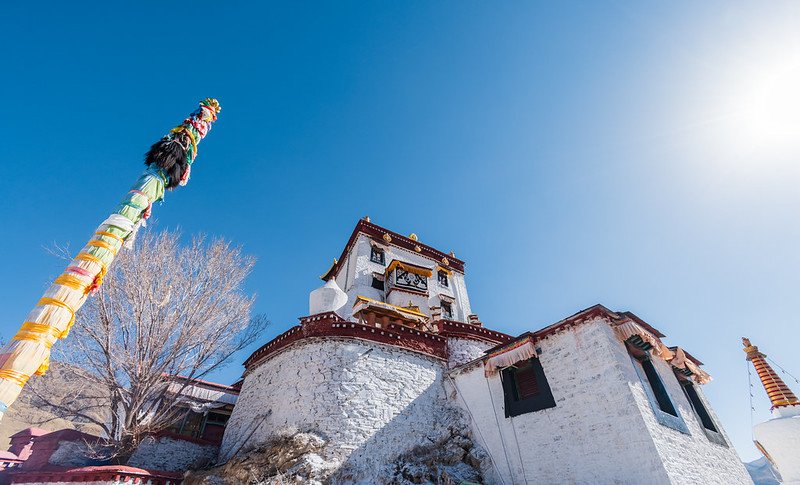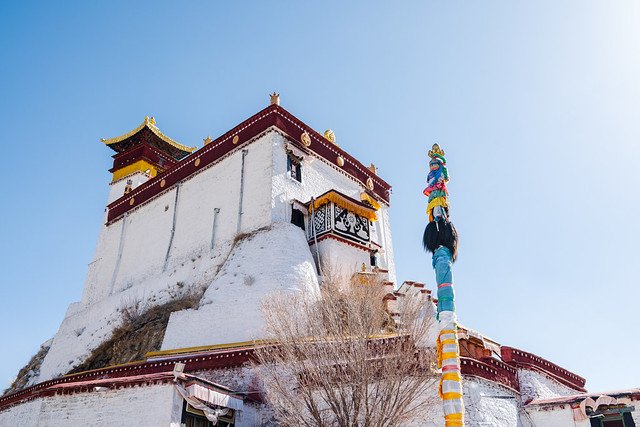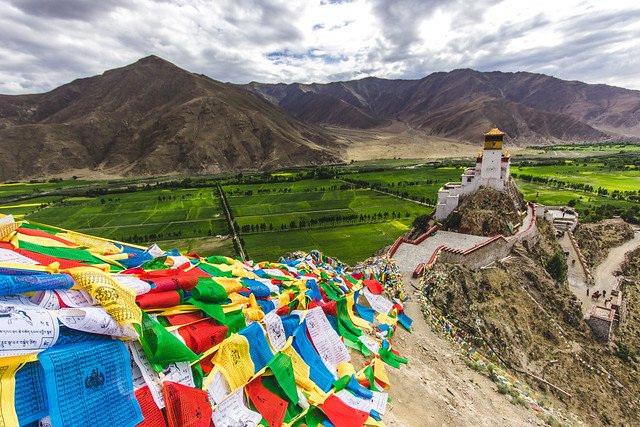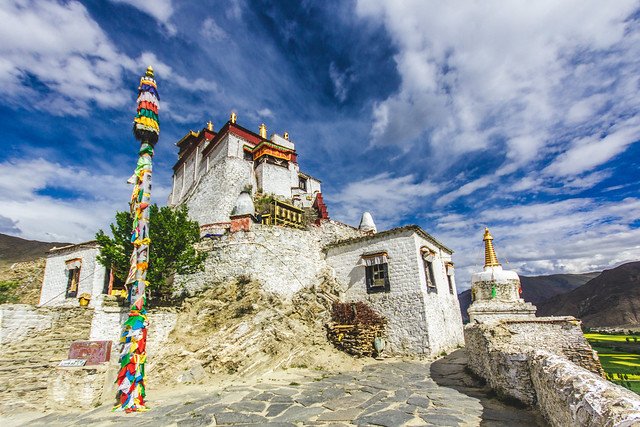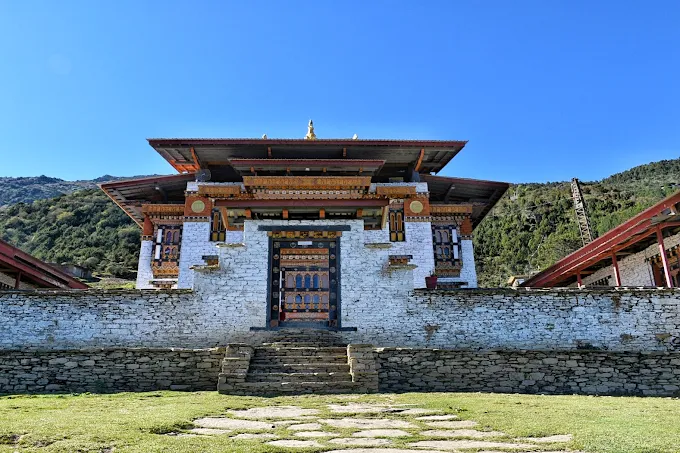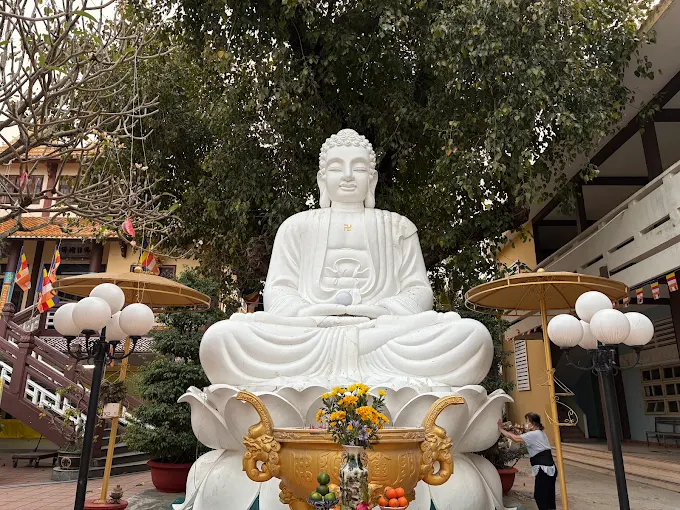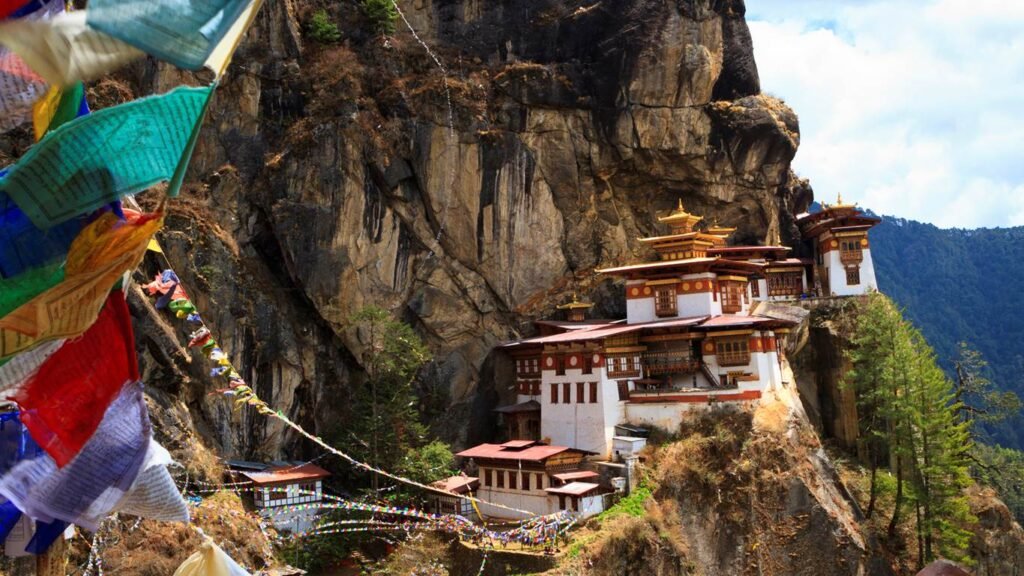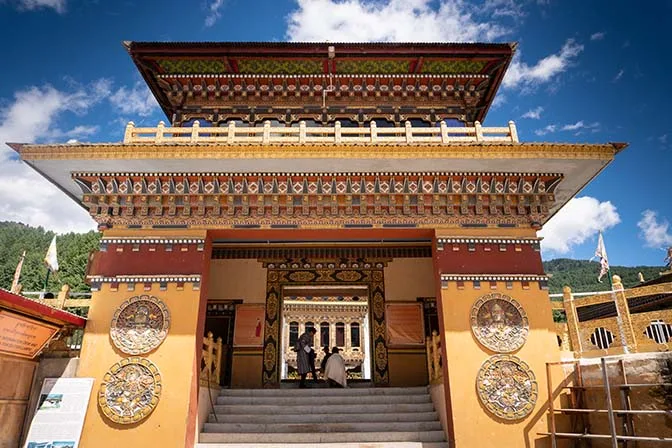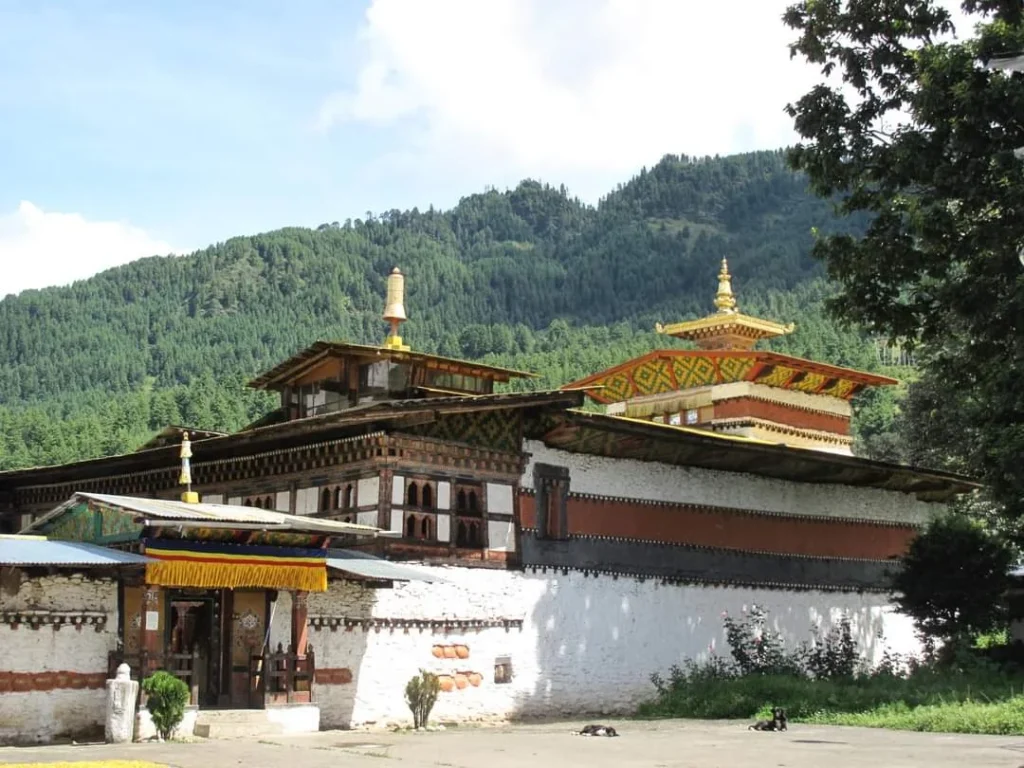Yumbulagang Palace: The Cradle of Tibet’s Ancient Kings
Yumbulagang Palace, perched atop a rocky hill in the Yarlung Valley near Tsedang, Tibet, stands as a timeless sentinel, revered as Tibet’s oldest palace and the ancestral seat of its first king, Nyatri Tsenpo. Built in the 2nd century BC and later transformed into a Buddhist chapel under King Songtsen Gampo, this sacred site blends royal history with spiritual serenity, housing a revered Sakyamuni statue. At 3,700 meters, its whitewashed walls and golden spire gleam against the valley’s lush fields, captivating pilgrims and travelers with its majestic allure. This immersive listing unveils Yumbulagang’s essence, guiding you through its storied past, architectural elegance, sacred rituals, and practical visitor insights, offering a journey into the heart of Tibetan heritage.
The Ancestral Soul of Yumbulagang
Essence of Yumbulagang Palace
Yumbulagang Palace radiates a profound historical and spiritual resonance, embodying Tibet’s ancient royal legacy and its early embrace of Buddhism. Founded in the 2nd century BC for King Nyatri Tsenpo, it is considered Tibet’s first palace, later converted into a Nyingma chapel in the 7th century. Its defining treasure—a gilded Sakyamuni statue, enshrined in the main hall—draws devotees seeking blessings in this cradle of Tibetan civilization. Crowning a hill in the Yarlung Valley, Yumbulagang’s serene grandeur invites reflection on Tibet’s origins.
- Spiritual Core: Tibet’s oldest palace, now a Nyingma chapel.
- Iconic Feature: Gilded Sakyamuni statue, sacred relic.
- Cultural Role: Cradle of Tibetan royal and Buddhist heritage.
Historical Evolution
Yumbulagang’s story began in the 2nd century BC when, according to legend, Nyatri Tsenpo descended from the heavens to rule Tibet, with the palace built as his seat, its name meaning “Palace of Mother and Son.” In the 7th century, King Songtsen Gampo converted it into a Buddhist chapel, aligning it with temples like Jokhang. The Cultural Revolution (1966–1976) damaged its structures, but restoration since 1982, funded by state grants and local devotees, revived its halls, preserving its historical and religious significance. A 1990 renovation added modern touches while retaining its ancient charm.
- Founding: Built ~2nd century BC for Nyatri Tsenpo.
- Conversion: Buddhist chapel under Songtsen Gampo, 7th century.
- Restoration: Revived since 1982, renovated in 1990.
Cultural Impact
Yumbulagang’s role as Tibet’s first palace shaped its cultural identity, symbolizing the Yarlung Dynasty’s origins and the dawn of Tibetan civilization. Its conversion to a Buddhist site marked the spread of Buddhism, influencing temples like Tradruk. Annual festivals, such as Losar, draw local pilgrims, preserving Nyingma traditions. Globally, Yumbulagang captivates historians and Buddhists, with its artifacts studied via HimalayanArt.org and its history documented in R.A. Stein’s Tibetan Civilization, resonating across Himalayan communities.
- Royal Legacy: Symbol of Yarlung Dynasty origins.
- Buddhist Influence: Early catalyst for Tibetan Buddhism.
- Global Reach: Inspires historians, Buddhist devotees.
Signature Legacy
The gilded Sakyamuni statue, enshrined in the main hall, is Yumbulagang’s crowning jewel, believed to radiate blessings since its 7th-century consecration. A sacred mural of Nyatri Tsenpo, depicting his divine descent, adorns the chapel, linking royal myth to Buddhist devotion. A legend recounts how a golden stupa, gifted by a naga spirit, was hidden in the palace’s foundation, affirming its sanctity. These relics anchor Yumbulagang’s historical and spiritual identity.
- Sakyamuni Statue: Gilded, 7th-century relic.
- Nyatri Mural: Depicts divine royal descent.
- Naga Stupa Legend: Sacred foundation relic.
Community and Global Reach
Yarlung Valley locals revere Yumbulagang as a pilgrimage site, offering butter lamps during festivals and life events. Its small monastic community of 10–15 monks, primarily Nyingma, maintains rituals and guides visitors, fostering spiritual continuity. The Tibetan diaspora visits to reconnect with their heritage, while international tourists, drawn by Tibet Travel and China Highlights, explore its halls. Social media posts on X and travel blogs amplify its cultural reach, connecting Yumbulagang to global audiences.
- Local Devotion: Butter lamp offerings by Yarlung residents.
- Monastic Community: 10–15 Nyingma monks guide pilgrims.
- Global Appeal: Attracts diaspora, tourists, historians.
Architectural Elegance of Yumbulagang
Distinctive Design
Yumbulagang’s architecture, spanning 2,000 square meters at 3,700 meters, blends ancient Tibetan fortress design with Buddhist chapel elements, its whitewashed walls and golden spire crowning a hill in the Yarlung Valley. The palace’s two-part structure—a lower watchtower and upper chapel—reflects 2nd-century BC defensive aesthetics, with later Buddhist additions like prayer wheels. The hilltop setting, overlooking lush fields, creates a majestic silhouette, unique to Yumbulagang’s royal and sacred identity.
- Style: Ancient Tibetan fortress, Buddhist chapel blend.
- Layout: Watchtower, upper chapel, prayer wheels.
- Setting: Hilltop in Yarlung Valley.
Signature Structures
The upper chapel, restored in 1982, houses the gilded Sakyamuni statue and Nyatri Tsenpo mural, glowing under butter lamp light. The lower watchtower, a three-story structure, features narrow stone corridors and a rooftop terrace with valley views. The Zangdok Palri Lhakhang, a side chapel, enshrines Chenresig and Tara statues, adorned with thangkas. The outer kora path, lined with prayer wheels, encircles the hill, inviting devotion. These structures embody Yumbulagang’s royal and spiritual grandeur.
- Upper Chapel: Sakyamuni statue, Nyatri mural.
- Watchtower: Stone corridors, rooftop terrace.
- Zangdok Palri Lhakhang: Chenresig, Tara statues.
Artisanal Mastery
Yumbulagang’s thangkas, crafted by local monks, depict Nyingma deities like Chenresig with mineral pigments, their hues vibrant post-1982 restoration. The Sakyamuni statue, gilded in the 7th century, showcases early Tibetan sculptural finesse, while the Nyatri mural blends royal and Buddhist iconography. Carved wooden beams, featuring lotus motifs, adorn the chapel, and silk thangkas of Songtsen Gampo hang in side rooms. These works, preserved through restoration, highlight Yumbulagang’s artistic legacy.
- Thangkas: Nyingma deities, vibrant pigments.
- Sakyamuni Statue: 7th-century gilded relic.
- Nyatri Mural: Royal-Buddhist iconography.
Hidden Architectural Gems
Yumbulagang conceals subtle treasures within its compact grounds. The watchtower’s rooftop terrace offers panoramic views of the Yarlung Valley, framed by prayer flags. A faded inscription in the Zangdok Palri Lhakhang, etched with mantras, hints at 7th-century artistry. The kora path’s base hides a small mani stone pile, carved with Om Mani Padme Hum, inviting quiet reflection. These details enrich Yumbulagang’s regal and sacred ambiance.
- Rooftop Terrace: Yarlung Valley views.
- Mantra Inscription: 7th-century Lhakhang etching.
- Mani Stone Pile: Mantra-carved kora base.
Preservation and Evolution
Preserving Yumbulagang’s ancient structures is a delicate task against Tibet’s harsh climate. Restoration since 1982, funded by state grants and local devotees, used traditional pigments for thangkas and reinforced stone walls. The 1990 renovation regilded the chapel’s spire, blending modern durability with ancient aesthetics. Ongoing efforts, supported by cultural preservation funds, ensure Yumbulagang’s legacy endures, despite erosion and seismic risks.
- Restoration: Pigments, wall reinforcements since 1982.
- Spire Regilding: Modern upgrade in 1990.
- Funding: State, local devotees.
Sacred Rites and Nyingma Devotion
Sacred Daily Rites
Each dawn, Yumbulagang stirs with gentle chants, as monks gather in the upper chapel, their voices blending with butter lamp smoke. Pilgrims offer khatas (silk scarves) at the Sakyamuni statue, their prayers mingling with juniper incense. The hum of prayer wheels along the kora path creates a meditative rhythm, enveloping visitors in Yumbulagang’s spiritual calm.
- Chanting: Morning sutras in upper chapel.
- Offerings: Khatas at Sakyamuni statue.
- Ambiance: Incense, prayer wheel hum.
Unique Spiritual Practices
Yumbulagang’s monks perform Nyingma rituals, including Chenresig-focused recitations to cultivate compassion, reflecting the sect’s tantric roots. Pilgrims walk the kora around the hill, spinning prayer wheels to accrue merit, a practice tied to the palace’s conversion by Songtsen Gampo. The Zangdok Palri Lhakhang hosts rare Tara blessings, unique to Yumbulagang’s Nyingma identity. These rituals, rooted in 7th-century devotion, deepen the site’s spiritual allure.
- Chenresig Recitations: Nyingma compassion rites.
- Kora: Hilltop prayer wheel circumambulation.
- Tara Blessings: Lhakhang-specific ceremonies.
Vibrant Festival Traditions
Yumbulagang’s festivals, though modest, echo the Yarlung Valley’s vibrancy. Losar (Tibetan New Year) features kora walks, lamp offerings, and prayers led by monks, drawing locals. Saka Dawa, marking Buddha’s enlightenment, includes Cham dances and communal feasts of tsampa (roasted barley) and butter tea. These events, uniting pilgrims and residents, reinforce Yumbulagang’s role as a cultural and spiritual hub.
- Losar: Kora, lamp offerings, prayers.
- Saka Dawa: Cham dances, communal feasts.
- Community Role: Tsampa, tea shared.
Visitor Engagement
Visitors can offer khatas or light butter lamps at the Sakyamuni statue, guided by monks, immersing in Yumbulagang’s spiritual life. Photography is permitted for a 10-yuan fee, capturing thangkas and murals, but flash is prohibited, and the main chapel may restrict close-up shots. Joining the kora lets travelers walk with pilgrims, feeling Yumbulagang’s sacred rhythm. Monks may share tales of Nyatri Tsenpo’s divine descent, enriching the visit with historical lore.
- Offerings: Khatas, lamps with monk guidance.
- Photography: 10-yuan fee, no flash, restricted chapel shots.
- Kora Participation: Walk with pilgrims.
Monastic and Community Roles
Yumbulagang’s 10–15 monks, primarily Nyingma, maintain daily rites, study texts, and guide visitors, upholding its spiritual legacy. They offer blessings for local harvests, weddings, and life events, strengthening Yarlung Valley ties. The palace trains young monks in thangka painting, preserving Nyingma artistry. This bond ensures Yumbulagang remains a living cultural and spiritual center, despite its small monastic scale.
- Monastic Duties: Rites, study, visitor guidance.
- Community Ties: Blessings for local events.
- Art Preservation: Thangka training.
Visiting Yumbulagang Palace
Navigating to Yumbulagang Palace
Yumbulagang lies 5 km southeast of Tsedang in Shannan Prefecture, 135 km southeast of Lhasa, atop a hill in the Yarlung Valley. From Lhasa, a 135-km drive via the G318 highway takes 2.5 hours by bus or private tour vehicle, passing Tsedang. From Tsedang, a 10-minute taxi or 15-minute drive along the Tsedang-Yumbulagang road reaches the palace, marked by its hilltop white walls. The nearby Tradruk Monastery, 7 km away, serves as a guiding landmark.
- From Lhasa: 2.5-hour drive, 135 km via Tsedang.
- From Tsedang: 10-minute taxi, 5 km southeast.
- Local Access: Short drive from Tsedang, near Tradruk.
Address of Yumbulagang Palace
- Location: Nedong County, Shannan Prefecture, Tibet Autonomous Region, China.
- Coordinates: 29.1833° N, 91.8000° E.
- Context: Yarlung Valley, 5 km southeast of Tsedang.
Visiting Hours and Etiquette
Yumbulagang is open daily from 9:00 AM to 6:00 PM, with early visits offering cooler temperatures and fewer crowds. Dress modestly, covering shoulders and knees, and remove hats in the chapel to show respect. Photography is allowed for a 10-yuan fee; bring a flashlight for dim interiors, avoid flash, and note that close-up shots of the Sakyamuni statue may be restricted. Respect pilgrims by maintaining silence and not touching relics or murals.
- Hours: 9:00 AM–6:00 PM, best in morning.
- Dress Code: Modest clothing, no hats in chapel.
- Etiquette: 10-yuan photo fee, no flash, restricted statue shots.
Accessibility and Safety
Yumbulagang’s grounds are accessible via a paved path to the hill’s base, but a steep 15-minute climb or horseback ride (available locally) reaches the palace, challenging for those with mobility issues. Wheelchair users require assistance due to stairs and uneven terrain; arrange with tour operators. The 3,700-meter altitude requires acclimatization; hydrate and rest to avoid sickness. The rural setting is safe, but watch for stray dogs and carry cash for fees.
- Accessibility: Paved base path, steep hill climb.
- Mobility Aids: Limited, arrange assistance.
- Safety: Acclimatize, watch for dogs, carry cash.
Amenities and Surroundings
Yumbulagang offers basic amenities, including restrooms at the hill’s base and a small shop selling khatas and souvenirs. Tsedang’s markets, 5 km away, serve momos (dumplings), butter tea, and yak-meat noodles, immersing visitors in local flavors. The hilltop terrace and kora path provide serene reflection spots with valley views. The Yarlung Valley’s fields and nearby Tradruk Monastery offer scenic exploration, enriching the visit.
- Amenities: Restrooms, small shop at base.
- Food: Tsedang markets with momos, tea.
- Surroundings: Hilltop terrace, Yarlung Valley, Tradruk.
Immersive Visitor Tips
Arrive at dawn to hear monks chanting in the upper chapel, their voices echoing through the hall, setting a meditative tone. Photograph the Nyatri mural from the chapel’s entrance at midday, capturing its details with a flashlight, paying the 10-yuan fee and avoiding flash. Walk the kora at dusk, when the valley glows golden, enhancing Yumbulagang’s majestic ambiance. Savor butter tea in Tsedang’s markets, chatting with locals about Nyatri Tsenpo’s legend for cultural insights.
- Dawn Visits: Hear chants in upper chapel.
- Photography: Mural shots, 10-yuan fee, no flash.
- Evening Kora: Valley views at dusk.
